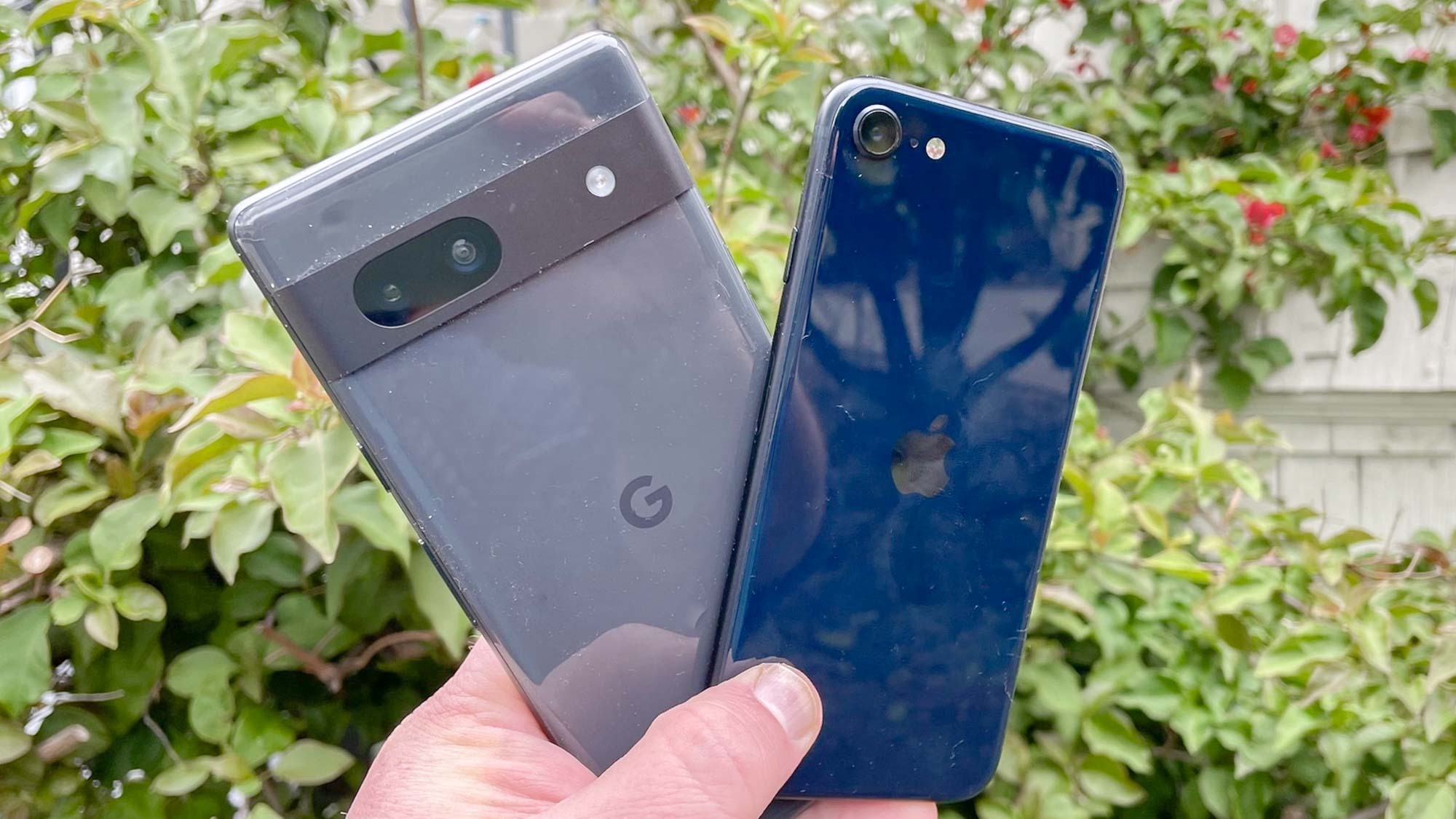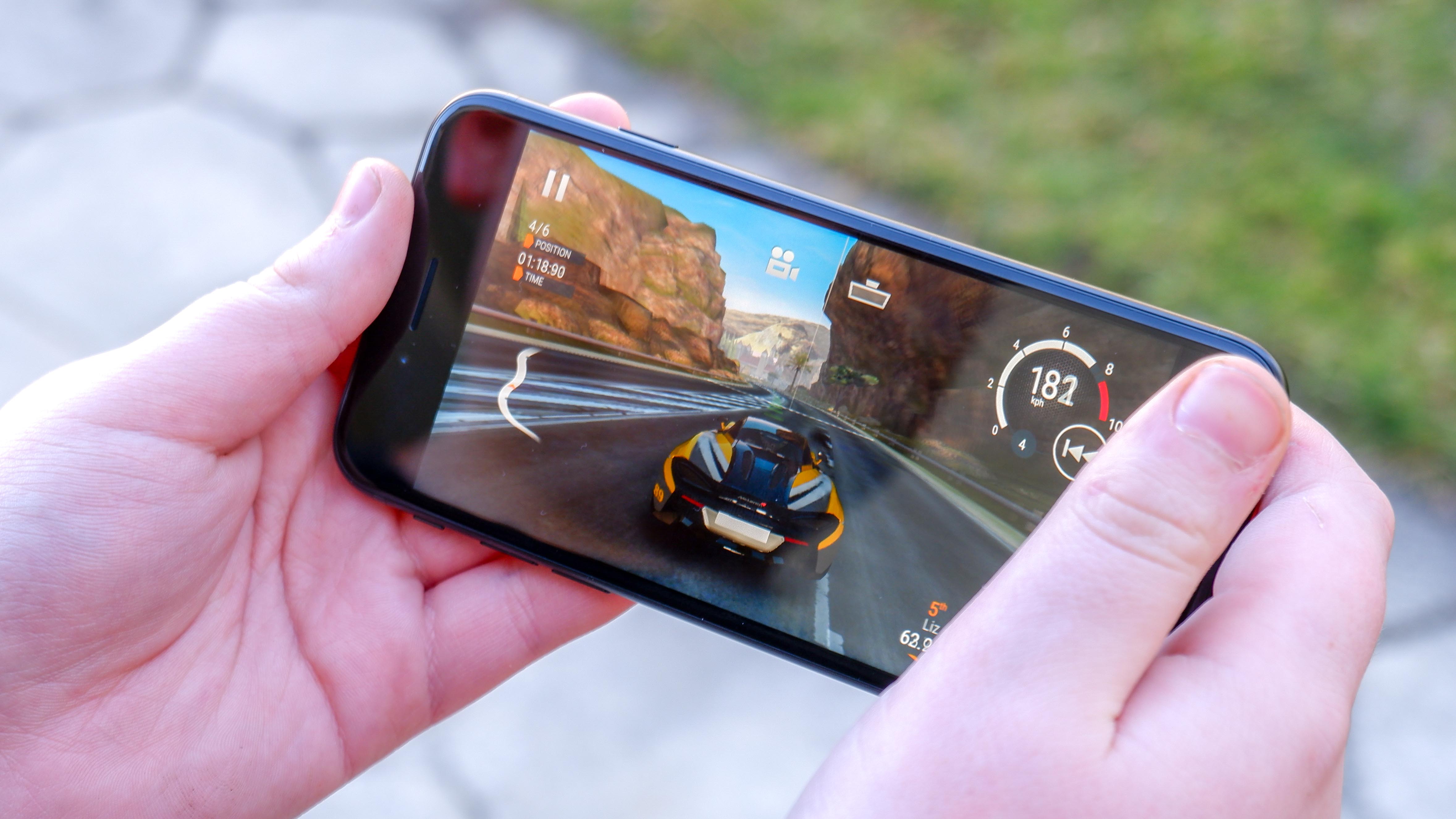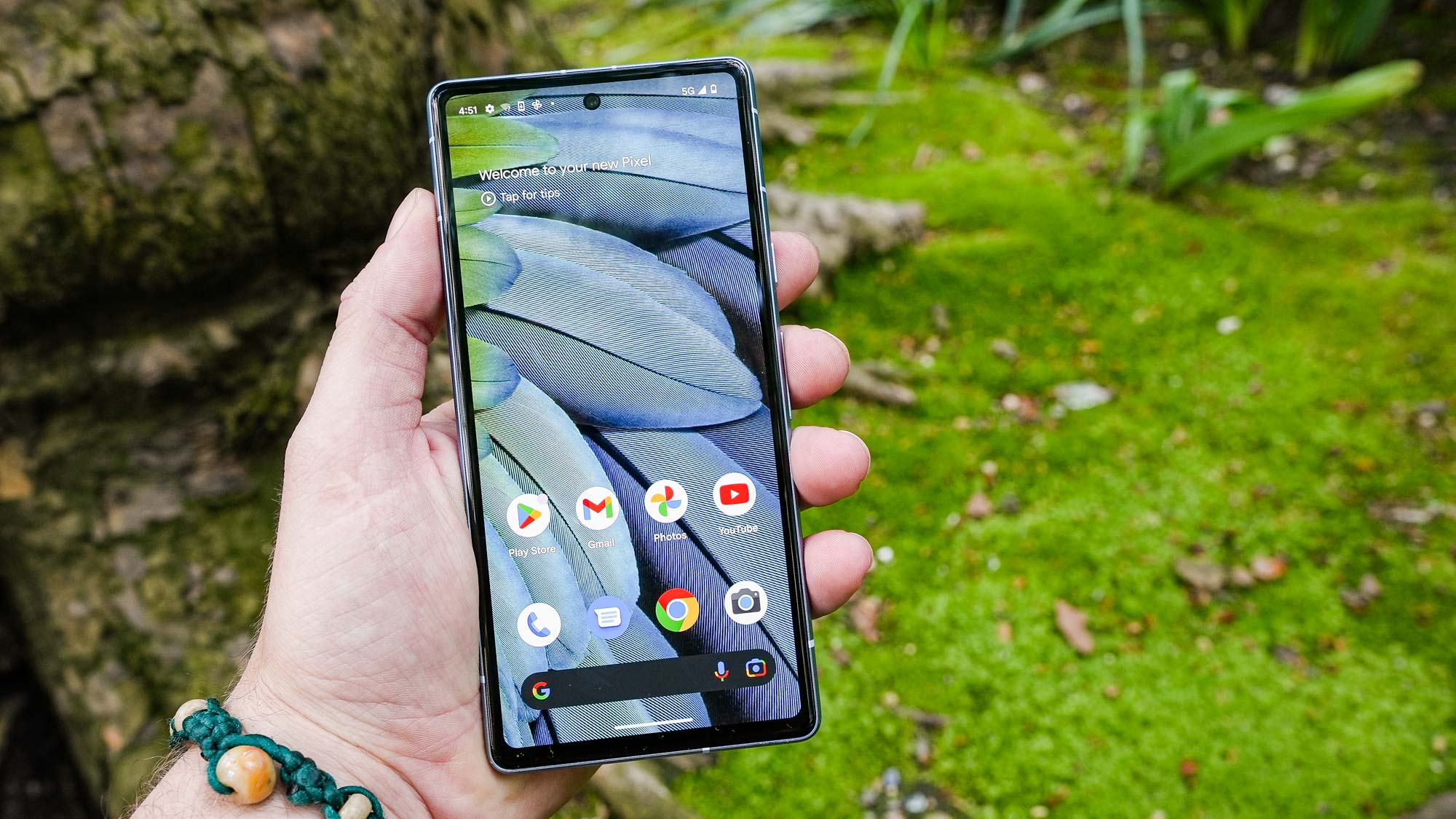
A Google Pixel 7a vs. iPhone SE comparison gives us a pretty clear view on the different approaches Google and Apple take toward low-cost phones. More importantly, it can help you decide which phone to get if you don't want to spend more than $500 on your next handset.
The iPhone SE 2022 certainly fits the definition of a low-cost phone. It's the least expensive device among the best iPhones, so you won't get some of the premium features you'll find on the iPhone 14 (and you'll definitely miss out on the higher-end capabilities of the iPhone 14 Pro). But you'll still find a phone that produces some pretty impressive photos despite its lone rear camera. Even more impressively, the iPhone SE can outperform many of the best Android phones on the market, thanks to a still-powerful chipset.
Google's Pixel 7a arrives a year after the iPhone SE's release, and it boasts a few premium features of its own, starting with AI-powered features supported by the Tensor G2 chipset inside the phone. The Pixel 7a also delivers outstanding photography in its own right, and Google has added a few premium features you wouldn't expect to see in a device that costs less than $500.
Which phone caught our eye when we compared these low-cost devices side by side? Here's how our Google Pixel 7a vs. iPhone SE face-off went down.
Google Pixel 7a vs. iPhone SE specs
Google Pixel 7a vs. iPhone SE price
The Pixel 7a costs $499, a $50 price hike over what Google charged for the Pixel 6a when that phone debuted last year. While Google still kept the price under $500, the increase only widens the price gap between Google's midrange device and the iPhone SE. Apple charges $429 for the base model SE — a $70 discount off the Pixel 7a.
Then again, price differences can be misleading. That $429 iPhone SE only comes with 64GB of storage. To match the 128GB found in the Pixel 7a, you'll need to pay another $50. So, to get a comparable iPhone SE, you're only saving $20 off the Pixel 7a's price.
Pixel 7a deals can lower the cost of Google's phone, just as the best iPhone SE deals can drop the price there. At the end of the day, the iPhone enjoys the edge on price, though it's not as big an advantage as you'd imagine.
Winner: iPhone SE
Google Pixel 7a vs. iPhone SE design
It's a tale of two designs when you look at the Pixel 7a and iPhone SE next to one another. The Pixel 7a adopts the same look as recent Google flagships, with a horizontal camera bar stretching across the back of the phone. From a distance, in fact, you'd be hard-pressed to spot the differences between a Pixel 7a and Pixel 7, though once you picked up both phones, the plastic back of the Pixel 7a would be a giveaway.
The nicest way to describe the iPhone SE's design is that Apple is embracing a vintage look. The SE resembles 2017's iPhone 8. That means no display notch, but also big bezels at the top and bottom of the 4.7-inch screen. It's a dated approach to phone design to say the least.

At least the iPhone SE can claim to be more durable than the Pixel 7a, as it uses a glass that's nearly as durable as the Ceramic Shield glass found on more expensive iPhones. Google uses the older Gorilla Glass 3 on its budget phone. Both phones promise IP67 water resistance, so they'll withstand a dunk in water.
Not only is the iPhone SE more compact than the Pixel 7a, it weighs nearly 2 ounces less as well. But the Pixel 7a offers more color options than the iPhone SE, which only comes in black, white or a [Product] Red variant. You'll find black and white (or Charcoal and Snow) Pixel 7a models, but Google gives you a choice of light blue and coral, too.
Winner: Google Pixel 7a
Google Pixel 7a vs. iPhone SE display
There's an obvious difference in screen size, with the Pixel 7a offering a 6.1-inch panel compared to that 4.7-inch iPhone SE screen. The iPhone features an LCD screen, too, in contrast to the OLED panel offered by the Pixel 7a.

That said, colors are remarkably similar, at least when the Pixel 7a is set to Natural mode. The iPhone SE captures a little bit more of the sRGB and DCI-P3 color gamuts, but only just. Switch the Pixel 6a to Adaptive mode and it captures a higher percentage of those gamuts. Its colors are more accurate in Adaptive, too, with a Delta-E rating of 0.05 to the iPhone SE's 0.21%. (Numbers closer to zero are better.)
The Pixel 7a enjoys two advantages over the iPhone SE when it comes to displays. First, it's brighter, hitting a maximum of 931 nits as measured by a light meter. The iPhone tops out at 596 nits. The Pixel 7a also supports a faster refresh rate of 90Hz while the iPhone SE is locked at 60Hz. This allows Google's phone to offer smother scrolling when the situation demands it.
Winner: Google Pixel 7a
Google Pixel 7a vs. iPhone SE cameras
It's not just the iPhone SE's design that's a throwback to several years ago; the phone's camera setup also hearkens back to olden times with a single 12MP rear camera to handle all your photographic needs. Some pretty powerful photo processing on the iPhone SE helps Apple's phone hold its own, but it's definitely at a hardware disadvantage.

Google seems to be headed in the opposite direction, though like Apple, its camera phones are distinguished by their strong computational photography powers. But Google also equips its budget phone with two lenses — a main camera and an ultrawide shooter.
In the case of the Pixel 7a, Google even upgraded the setup from past Pixel A phones so that the main camera relies on a 64MP sensor. A 13MP ultrawide angle camera makes up the remainder of the rear lenses on Google's phone.
A photo from indoors at night shows the benefits of the Pixel 7a's larger sensor. Because it lets in more light, it's able to capture more details and produce truer colors than you'll find in the iPhone SE shot.
I actually like what the iPhone SE has done with this photo of a Star Wars-themed dinner. But its colors are a bit muted compared to the Pixel 7a shot, where the blue milk looks much more blue, and the crumb-crisp coating on the filet of Porg — all right, all right, it's a chicken breast — is warmer and more inviting. As good as the iPhone SE photo is, the Pixel 7a's shot is just a bit better.
When testing the Pixel 7a, I've noticed it tends to favor darker colors and more shadows in its photos. That's very much in evidence in this grocery store shot featuring an array of different colored peppers. The yellow and orange peppers in particular have a darker cast than what you see in the iPhone SE photo, for example.
You could argue that the iPhone SE shot runs the risk of over-exposing that top row of peppers. But I also think the green and red peppers look brighter in the iPhone SE's photo, too, giving it the edge here over the Pixel 7a.
Both phones took a pretty decent shot of a decommissioned Navy fighter plane converted into a statue. The Pixel 7a has taken a more realistic shot, though I'm struck by the richer blue of the sky and the lush green grass of the iPhone SE image. Some heavy lifting is being done by the image processing on the iPhone SE, but it's a really pleasing effort.
Based on those three photos, you'd think the iPhone SE can keep pace with the Pixel 7a, and even beat it in some scenarios. You'd be correct, as we've always considered the iPhone SE to be one of the best camera phones for less than $500.
But you also have to consider what a camera phone can't do. The lack of an ultrawide lens on the iPhone SE means we can't compare it to the Pixel 7a's output from its 13MP ultrawide camera. And because the iPhone SE lacks support for a Night mode, its pictures in the dark are not going to measure up to what the Pixel 7a can do.
The iPhone SE tries its best in this shot of me on my porch enjoying a martini, with only ambient lighting from inside the house to illuminate the scene. This is one of the Pixel 7a's weaker efforts in my testing — my skin is unnaturally orange, and the martini itself is lost in the shadows. I'm in focus, but there's a lot of noise in the picture.
But the iPhone SE is robbed of any color, unnatural orange or otherwise. There's no attempt to pluck details out of the shadows. Even worse, I look pretty grainy in the iPhone SE shot. A little Night mode would go a long way here.
Matters improve for the Pixel 7a at least when we check in on some stuffed animals in a completely darkened scene. You can see the colors of each stuffed animal in the Pixel 7a shot, and even background details like flowers emerge from the darkness.
Everything's nearly pitch black in the iPhone SE photo. You can't even tell if that's one stuffie or two over Kermit's right shoulder, and what little color there is gets completely muted in the darkness.
It's a shame because in other scenarios, the iPhone SE's lone camera shows that you can do more with less. But because Apple won't support a Night mode for its cheap phone — presumably to get people to upgrade to more expensive models — it's impossible to recommend the iPhone SE as a camera phone over the more capable Pixel 7a.
Winner: Google Pixel 7a
Google Pixel 7a vs. iPhone SE performance
Comparing Pixel 7a vs. iPhone SE benchmarks is as close to a no contest as you can get, though Google would argue that its not trying to compete with Apple phones in terms of raw performance. Rather, the Tensor G2 chip that powers the Pixel 7a focuses more on the silicon's Tensor Processing Unit and the on-device machine learning that can result from all that computational power. We'll discuss that in greater depth in the software section, since Tensor is all about the AI-driven experiences it can enable.
But that leaves the Pixel 7a at the mercy of the iPhone SE, which features the same A15 Bionic chipset found in the iPhone 13 lineup. (The iPhone 14 and iPhone 14 Plus also run on an A15 Bionic, but their version features an additional graphics core.) The Pixel 7a may be using the same silicon found in Google's Pixel 7 flagships, but the iPhone SE's older A15 can still out-muscle both.
The iPhone SE's score of 4,482 on Geekbench 5's multicore test is 46% better than the Pixel 7a's 3,065 result. The gap isn't as noticeable on 3DMark's Wild Life Unlimited graphics test, but the iPhone SE's 50 frames per second result is comfortably ahead of the 41.1 fps score produced by the Pixel 7a. When we used Adobe Premiere Rush to transcode a video on both phones, the iPhone SE beat the Pixel 7a's time by nearly 30 seconds.
The Pixel 7a is no performance slouch, though it does heat up noticeably when you play graphically intense games. Still, the iPhone SE easily out-performs it in every measurable way.
Winner: iPhone SE
Google Pixel 7a vs. iPhone SE battery life and charging
The iPhone SE's small size doesn't leave a lot of room for a big battery, and teardowns reveal that Apple is using a 1,624 mAh power pack in its cheapest phone. Even the power-efficient A15 Bionic is going to have a hard time squeezing a lot of life out of that, and our iPhone SE battery test result reflects that. When we had Apple's phone surf the web continuously over cellular, it held out for 9 hours and 5 minutes before running out of power. That's about 50 minutes shorter than the average smartphone.

Armed with a 4,385 mAh, the Pixel 7a does quite a bit better on our battery test. It lasted 10 hours and 5 minutes, beating the iPhone by an hour and finishing just ahead of the average smartphone. That time came with the Pixel 7a's display set at a 60Hz refresh rate, which is the same as the iPhone SE's display. We're going to test the Pixel 7a with its adaptive refresh rate turned on; typically that feature tends to be more power-hungry, reducing performance on our battery test.
Neither phone charges particularly quickly. The Pixel 7a supports 18W wired charging speeds while the iPhone SE can charge at 20W. The Pixel 7a adds support for wireless charging, negating an advantage the iPhone held over other cheap phones.
Winner: Google Pixel 7a
Google Pixel 7a vs. iPhone SE software and special features
Normally, any iPhone would enjoy a big software edge over an Android device, thanks to Apple's lengthy software support for its phones. iPhones tend to get five years of software support, which means that the iPhone SE 2022 will be able to support whatever version of iOS Apple releases in 2027. The Pixel 7a can only count on three Android OS updates, and one of those — Android 14 — is arriving later this year.
However, this is where the experiences powered by the Tensor G2 chipset inside the Pixel 7a really shine through. Like the Pixel 7 before it, the Pixel 7a is capable of a number of things you won't see on other mobile phones, including Apple's handsets.

If you've got photos where someone's face is a little blurry, the Pixel 7a's Photo Unblur feature uses AI to clear things up. The feature even works on photos shot by other devices — including the iPhone SE. Features like Direct My Call, which offer an on-screen menu of phone directories for 800-numbers, and Speaker Labels in the Pixel's Recorder app add a layer of intelligence you don't get from the iPhone's Siri assistant.
The iPhone SE gives you a low-cost entry point into the outstanding iOS ecosystem. But as nice as that is, the Tensor-powered features available to Pixel 7a owners are just a little bit more impressive.
Winner: Google Pixel 7a
Google Pixel 7a vs. iPhone SE verdict
The iPhone SE had better thank its A15 Bionic silicon. Because without the dominant performance driven by that chipset — not to mention the photo processing features it supports — the Pixel 7a would blow away Apple's cheapest phone. As it stands, the Google Pixel 7a vs. iPhone SE face-off is merely convincing win for Google's device instead of an overwhelming one.
The iPhone SE's low price, powerful processor and impressive camera keep it in the conversation for best cheap phones. But that dated design and subpar battery life leave plenty of space for a better phone to come along.
That better phone is the Pixel 7a. We love the fact that it offers a fast-refreshing display, wireless charging and the same Tensor chipset as Google's current flagship without costing more than $500. Google's stellar cameras remain a reason to consider its smartphones, but the Pixel 7a adds a lot more to the story.







